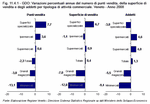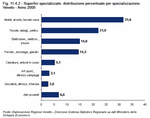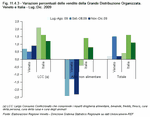We shall now deal in greater detail with a special sector of the retail trade, Large-scale Organised Distribution (LOD), with a view to analysing the development of modern distribution channels. Within this framework, large-scale distribution outlets have exhibited a positive trend: growing sales in large-scale distribution were almost completely ascribable to the food sector owing to a shift in purchases from small-sized shops to modern distribution channels, as well as to the social and cultural characteristics of buyers and the policies of price curbing in distribution chains in order to ensure value-for-money
(Table 11.4.1) and
(Figure 11.4.1).
 Department stores, supermarkets and hypermarkets
Department stores, supermarkets and hypermarkets
In 2008 there were 1,228 stores-department stores, supermarkets and hypermarkets-in Veneto, a slightly higher number compared to 2007. These stores are mainly located in the provinces of Verona, Padova, Vicenza and Treviso, each of which had more than 200 active stores. The average sales area covered by department stores, supermarkets and hypermarkets in Veneto is 1,228 m² and almost 27,000 people are employed in this sector.
These kinds of stores are open to organisational innovation as they make frequent use of forms of economic integration. Among the forms of vertical integration we could mention is voluntary association, which is governed by regulations and involves a shared trademark. Voluntary association involves one or more retailers, wholesalers or stores which agree to work together (though keeping their legal and financial independence) in order to pool purchases and some services with the main aim of increasing sales. The best known form is franchising, which is an agreement between two legal persons that are legally and financially independent where one party grants the other a set of industrial or intellectual property rights (concerning trademarks, trade names, store signs, utility models, designs, copyrights, know-how, patents, technical and sales assistance or consultancy) in exchange for an agreed amount of money. The franchisee becomes part of a network with the aim of trading goods or services in the territory. A total of 677 out of 1,228 supermarkets, hypermarkets and department stores use these forms of economic association. In particular, 45% of all stores taken into account belong to buying groups and almost 5% are part of voluntary associations and franchising agreements. These are the most developed and the best established forms of distribution and they have experienced constant growth over the years.
Hypermarkets seem to be particularly well established in Veneto as they exhibit sustained growth. Their year on year variation for 2008/07 was +3.6% for the number of stores and +4.6% in terms of employees; the total sales area, however, fell by 1.4%. This kind of store met the approval of consumers, who opted for cheaper goods especially as the crisis worsened. Supermarkets, a quite mature form of distribution, have performed constantly over time with relatively modest growth. At the end of 2008, the number of supermarkets in Veneto grew by 0.6% year on year and their corresponding sales area increased by 0.9% over the same period. Labour trends were definitely more positive as the number of people working in the sector grew by 4%.
Conversely, although Veneto's department stores experienced a period of expansion, one contributing factor being that they restricted their range to certain kinds of goods, they have possibly exhausted their potential for growth. At the end of 2008, the number of department stores shrank by 3.8% year on year with a corresponding 7% reduction in sales area; these figures are probably due to the fact that department stores, which are mainly unspecialised, had to compete with highly specialised stores. The number of employees in this sector also fell by 5.5% compared to 2007.
 Minimarkets
Minimarkets
Minimarkets, or small- and medium-sized stores which resemble convenience stores in more than one aspect, have spread in densely populated areas such as town or city centres. These kinds of stores gained some stability, but over the last year have fallen sharply both in number and size of stores and in number of employees. The overall number of minimarkets in Veneto on 31 December 2008 was 419, with a total sales area of 127,000 m² and 2,275 employees. In 2008 the number of minimarkets in Veneto fell by 13.1% with a reduction in sales area of 12.8% compared to the previous year; over that period, the number of people employed in these stores decreased by 9.4%, whereas in Italy they increased by 5%.
The most widespread form of economic integration among minimarkets is the buying group. Nearly one store owner out of two states he/she joined some kind of association with other sellers in 2008. Almost 9% of stores have entered a franchising agreement, while voluntary associations slightly exceed 3%.
If the distribution of minimarkets in the region's territory is studied, it becomes clear that they are quite widespread in the provinces of Treviso, Verona and Padova, whereas the provinces of Rovigo and Belluno have fewer than 30 each. Veneto has 7.9% of Italy's minimarkets and 38.5% of those in the North East. In southern Italy and on the islands these kinds of stores are still quite widespread; their share of the national total is quite high and their yearly growth is fairly strong.
 Specialised stores
Specialised stores
One of the most lively kinds of stores is the specialised large-scale distribution store, which is among the most recent forms of organisation. It is quite widespread especially in the non-food sector, which started to modernise its distribution later than other sectors. In 2008 in Veneto there were nearly 200 specialised stores covering an area of more than 548,000 m². In 2008, the number of people employed in specialised stores fell below 5,000 units, though they still accounted for over 10% of the Italian total. Specialised stores are mainly found in the provinces of Verona, Treviso and Padova with 57, 48 and 39 stores respectively in 2008. Each province had specialised stores with sales areas covering more than 100,000 m² each.
Data confirm that specialised large-scale distribution stores use economic integration very little. Only 15% of specialised stores operate as buying groups, while the share of franchising agreements or voluntary associations runs into just a few percentage points.
Sales areas grew at a steady pace. The annual variation in the number of stores was 7.7% and the increase in sales area was 6.7% in 2008. Although specialised stores had greater annual variations than other types of stores and also exceeded Italy's average growth, they underwent a slight contraction in the number of employees, -3.8% compared to 2007.
If the goods these stores specialise in are considered, furniture, furnishings and upholstery for home furnishing prevail in Veneto with 31.6% of stores, followed by textiles, clothing and furs (21.9%), electrical appliances, electronics and computing (14.9%), then hardware, DIY and gardening (14.3%)
(Figure 11.4.2).
 Sales in Large-scale Organised Distribution in 2009
Sales in Large-scale Organised Distribution in 2009
The pattern of sales in large-scale organised distribution (LOD) can be monitored through a Unioncamere-REF survey
(Note 1). Sales turnover of LOD in Italy grew 1.2% overall in 2009 compared to 2008 as a consequence of the 1.7% increase in the purchase of Consumer Packaged Goods
(Note 2) and the 0.8% decrease in the consumption of non-food products
(Note 3). In Italy there was also a recovery in the purchasing power of household income supported by a reduction in the cost of a basket of shopping, which started decreasing in mid-2009. In the last two months of the year, the variation in prices settled at -1% on a yearly basis, the same value as in September-October. However, sales turnover increased by 1.2% year on year in late 2009 as a result of an improvement in the last two months of the year, after sales had dropped in first half-year.
In Veneto data relating to 2009 show stable LOD sales compared to the previous year, i.e. +0.1% as a result of a 0.8% increase in Consumer Packaged Goods and a 3.7% decrease in non-food products. After the first half-year 2009 when Veneto's LOD sales grew more than at national level (+2.8% compared to +2%), Veneto's consumers became more cautious. In the two summer, autumn and winter months, sales in Veneto were stable and not so distant from the increase of over 1% in Italy
(Figure 11.4.3).









